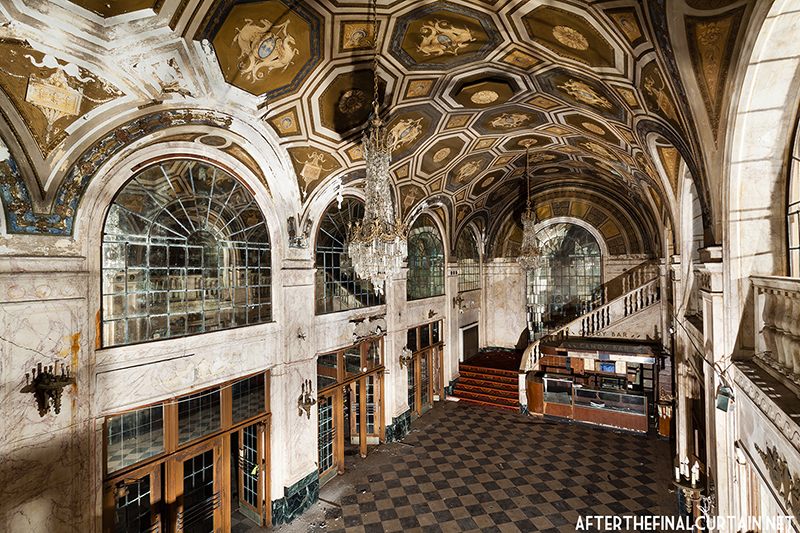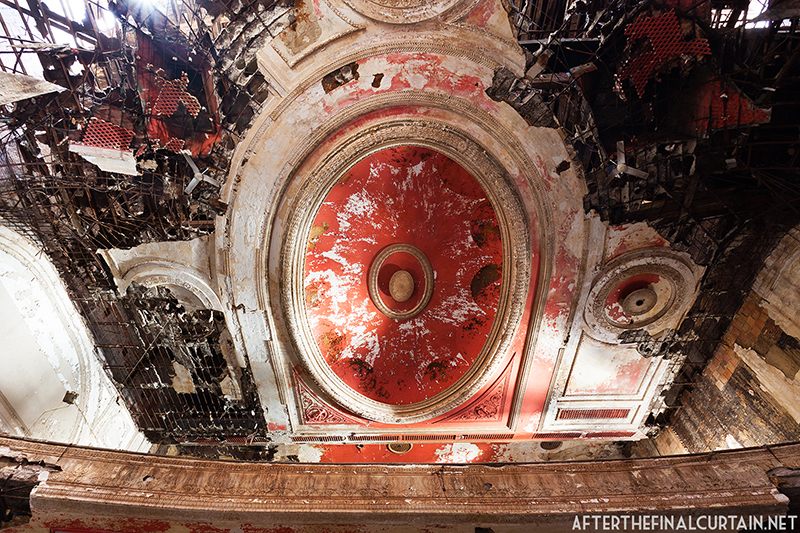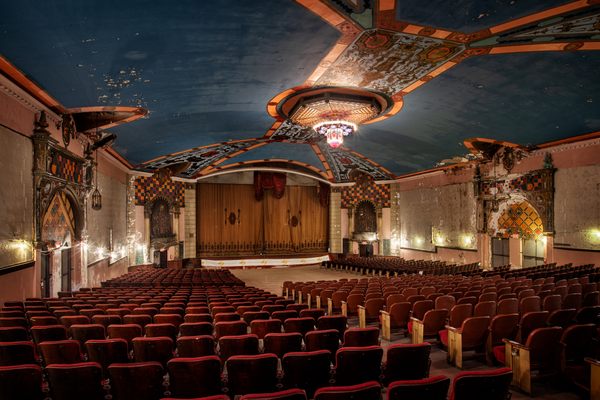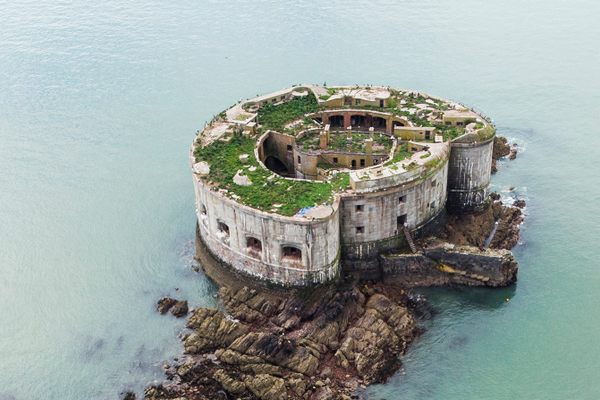Photos of Majestic Theaters Turned To Ruin
 The entrance of the Majestic Theatre, which opened in 1922 in Bridgeport, Connecticut. Today, the auditorium is used as a storage space for a local cabaret theater company. (All photos: Matt Lambros/After The Final Curtain)
The entrance of the Majestic Theatre, which opened in 1922 in Bridgeport, Connecticut. Today, the auditorium is used as a storage space for a local cabaret theater company. (All photos: Matt Lambros/After The Final Curtain)
In November of 1922, the Loew’s Majestic Theatre in Bridgeport, Connecticut celebrated its opening with a special event, a revue titled “Make It Snappy”. The Majestic lived up to its name: it was designed by the well-known theater architect Thomas W. Lamb in a Neo-Renaissance style, with a seating capacity of 2,200 and a lobby decorated with real marble.
It soon became a popular venue. By 1939, the Majestic and its sister theater, the Loew’s Poli, threw a party to mark the visit of their “ten millionth patron,” a Mrs. Richard G Rossbaum. She won free tickets for the following six months. The Majestic was operational until the 1960s, and closed permanently in 1975. After decades of neglect, today the seats are gone and the tiles in the mezzanine are cracked.
Matt Lambros has spent the last five years photographing once-glamorous, now derelict theaters such as the Majestic. His project, After The Final Curtain, is as much a photographic record as it is an account of a lost era, a reminder of a time when going to the theater was an occasion. We spoke with Matt about his experiences of shooting decaying theaters around the country.
Could you also tell me about how you came to work on this project?
I’ve been sneaking into abandoned buildings since I was pretty young, and it didn’t occur to me that I should be documenting them until the early 2000s. I’d traveled up and down the East Coast photographing old asylums and industrial buildings. Around 2009 I started growing tired of it and was looking for a new project. I went to see a film at the Village East Cinemas with some friends and spent most of the time admiring the architecture. Most of the asylums I had visited had theaters, and they were always my favorite part of the buildings. I started to wonder if there were abandoned theaters, and made a point to start researching when I got home that night. The first one I found was the Loew’s Kings Theatre in Brooklyn, New York, and I was hooked. I started “After the Final Curtain” after I had documented five or six theaters. I’ve traveled across the entire country photographing them.
What were some of the challenges of shooting such large spaces?
Well, the auditoriums can be quite tricky especially since a lot of the theaters no longer have power. Occasionally I’ll luck out and there will be construction lights that I can use to help light the cavernous auditoriums, but if that’s not an option I’ve developed a system that works for me. I always carry at least four handheld LED lights with me. They’re small, but have a surprising amount of power. The photograph from the Fox Theatre in Inglewood, California was taken only using two of those lights.
 The Fox Theatre in Inglewood, CA opened on March 31, 1949, and was built on the site of another theater that had burned down. It closed in 1988.
The Fox Theatre in Inglewood, CA opened on March 31, 1949, and was built on the site of another theater that had burned down. It closed in 1988.
How do you hear about abandoned theaters, and how do you get access?
I find abandoned theaters a few different ways. There are a number of websites devoted to old theaters, such as Cinema Treasures, organizations such as the Theatre Historical Society of America have also been a big help. As the project has become more well known, I’ve actually been contacted by theater owners asking me to come photograph their buildings. I gain access to the building mostly out of sheer persistence. I’ve been to around 80 theaters at this point, but I’d say for each one I’ve been to there’s about three or four that I was not allowed inside.
What is the significance of a theater, and why do they appeal to you?
The architecture and the history of these spaces continues to fascinate me. I grew up in the ’80s and ’90s, and there really wasn’t anything special about the movie theaters I went to while I was growing up. I love that it was such an event. You’d dress up, and not just see a movie, but a vaudeville show or maybe a live orchestra performed. Sometimes the stars of the film you came to see would make a personal appearance before the show. It’s just so different from how most movies are shown today.
Of all the theaters that you have photographed, do you have a favorite, and why?
My favorite would have to be the Loew’s Kings Theatre in Brooklyn, now just the Kings Theatre. It was the first one I photographed and started me on this path. It recently reopened after a $95 million restoration, and I photographed it every step of the way for my upcoming book, Kings Theatre; Rise, Fall and Rebirth of Brooklyn’s Wonder Theatre. It should be out late this year.

↑ The Lobby of Poli’s Palace Theatre, which opened on September 4, 1922 in Bridgeport, Connecticut. It was bought by Loew’s in 1934 and the name was changed to the Loew’s Palace Theatre. Loew’s sold the theater in the early 1970s and after showing adult films for a few years, the Palace closed permanently in 1975.

↑ The State Palace Theatre in New Orleans, LA opened on April 3, 1926. It eventually became a live performance venue. After closing due to the damages caused by Hurricane Katrina, the theater reopened sporadically as a rave venue. It was shut down on February 15, 2007 due to fire code violations.

↑ The ceiling of the Paramount Theatre, which opened on October 11, 1886 as H.C. Miner’s Newark Theatre. It was remodeled by famed theater architect Thomas W. Lamb in 1917, and renamed the Paramount Theatre. It closed on March 31, 1986 due to an increase in insurance rates, which also caused the nearby Adams Theatre to close.

↑ Proctor’s Palace Theatre (later RKO Proctor’s Theatre) in Newark, NJ. It opened on November 25, 1915 and was designed by architect John W. Merrow, the nephew of Proctor theater circuit owner Frederick F. Proctor. It closed in 1968 when RKO merged with Stanley Warner, who owned Newark’s larger and more profitable Branford Theater. The lobby was converted into retail use and currently houses a shoe store.

↑ The chandelier at Loew’s Canal Theatre, which opened in September 1927 in New York, NY. On the morning of September 10, 1932, an explosion rocked the front of the Loew’s Canal, throwing the ticket booth into the street and shattering windows on a number of neighboring buildings. No one was injured in the blast, but Edward Brown, the theater’s night watchman, was thrown down a flight of stairs by it. A similar explosion destroyed the entrance of the Loew’s 46th Street Theatre an hour earlier. Both bombings were thought to be connected to the Motion Picture Operators’ Union Local 306, who were on strike at the time and protesting in front of both theaters, but nothing was ever proven. It is currently used as a warehouse.

↑ The Kenosha Theatre opened on September 1st, 1927 in Kenosha, WI. It closed 36 years later. The building was used as a warehouse and a flea market before being closed permanently. The current owners are looking to restore the theater.

↑ The Loew’s 46th Street Theatre opened as the Universal Theatre in Brooklyn, NY on October 9, 1927. It was taken over by Loew’s less than a year later. After a short stint as an independent movie theater it closed in 1970. It was reopened later that year as the 46th Street Rock Palace, and was later renamed Bananafish Garden. Many famous bands played shows at the theater during the years it was a concert venue including; The Byrds, The Grateful Dead, Jerry Lee Louis, The Bee Gees, Steely Dan, Gladys Knight and the Pips and Randy Newman. It was later used as a furniture warehouse and is currently being demolished.

↑ Loew’s Kings Theatre/Kings Theatre Brooklyn, NY opened on September 7, 1929 and closed almost 50 years later in 1977. It was restored and reopened earlier this year, as seen in the photograph below.

















Follow us on Twitter to get the latest on the world's hidden wonders.
Like us on Facebook to get the latest on the world's hidden wonders.
Follow us on Twitter Like us on Facebook